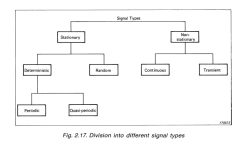Perhaps, but topologies and design motivations were different. It was also as easy to use feedback to reduce a compromise as much as it was to force a smaller or cheaper product.In the 50s-60s, every self respected high quality (tube) amplifier had feedback.
Maybe, my personal take on this, is that it mostly has to do with very strong marketing from certain companies in the later years.Perhaps, but topologies and design motivations were different. It was also as easy to use feedback to reduce a compromise as much as it was to force a smaller or cheaper product.
Also PCB's were never a strange problem in the 50s/60s, but all of a sudden everything had to be hand wired again?
Anyway, we are getting heavily offtopic here.
Thank you for doing this. I second the suggestion of error correction as another potential topic. Actually, just about any audio related topic would be nice.
I was browsing just some old magazines the other day.
In the 50s-60s, every self respected high quality (tube) amplifier had feedback.
For some reason that all of a sudden became out of fashion when it comes down to tube amplifiers.
Also for transistor amplifiers. I have the impression it all started with a mistake in a 1966 article about transistor amplifiers, see http://linearaudio.net/sites/linearaudio.net/files/volume1ltemvdg.pdf for details.
In the 50-ies and 60-ies, tube amps were designed by people who understood the facts of engineering.
If you really don't understand feedback in a technical way, it's an easy step to leave it out of your design and claim it's an improvement.
Especially with perception being the way it is.
Jan
If you really don't understand feedback in a technical way, it's an easy step to leave it out of your design and claim it's an improvement.
Especially with perception being the way it is.
Jan
Here's the next column:
Jan
Audio Myths: Feedback Re-Entrant Distortion. Should We Worry?
I would appreciate factual comments; not really looking for things like cut-and-paste reproduction of Wikipedia pages.Jan
It is already a lost fight. There is a whole forum here based on mystifying the readers. But, the argument is that it is a fashion business and that it is done to have fun, no serious engineering.
According to Feldtkeller's analysis from 1936, that's mainly an issue at low levels of feedback. Mind you, he was looking at third-order distortion.
Interestingly enough, with pure H3, FB distortion reduction is much more effective than for pure H2 (post #27) and creates only new odd order harmonics very very low in amplitude, in fact completely negligible. It is a demonstration of feedback capabilities.
Pure H3 nonlineraity
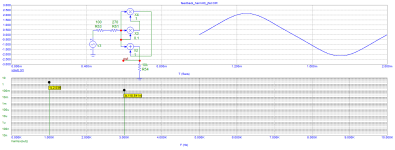
H3 nonlinearity corrected by feedback with LME49860
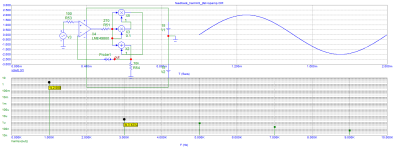
Maybe it's time to use modern SW means and to re-analyze FB action for various loopgains and nonlinearities.
BTW, the distortion suppression is defined by open loop gain (at the distortion component frequency) of the opamp used. In case of gain 1 (here) the open loop gain equals to loop gain.
Last edited:
Looking forward to some serious designs coming from the engineering corner, aimed at educational value for readers and builders. This without commercial intentions.It is already a lost fight. There is a whole forum here based on mystifying the readers. But, the argument is that it is a fashion business and that it is done to have fun, no serious engineering.
My intention with these postings is the same as the intention with which I wrote them for AX.
I am hoping to reach audio enthousiasts who would like to learn, in a simple and not too time consuming way, about these subjects.
What I see is that my posts are immediately highjacked by seasoned engineers that proceed to take it to a high level where it is unreachable for non-EEs.
It appears that my project has failed before it got well underway.
Disappointing.
Jan
I am hoping to reach audio enthousiasts who would like to learn, in a simple and not too time consuming way, about these subjects.
What I see is that my posts are immediately highjacked by seasoned engineers that proceed to take it to a high level where it is unreachable for non-EEs.
It appears that my project has failed before it got well underway.
Disappointing.
Jan
I do not think so. Diyaudio might be a way of pre-reviewing or reviewing the article, do not you think so, Jan? And you can take whatever you want, something or nothing. These are pros and cons of any public discussion.What I see is that my posts are immediately highjacked by seasoned engineers that proceed to take it to a high level where it is unreachable for non-EEs.
It appears that my project has failed before it got well underway.
Disappointing.
No I don't think so. I clearly stated my intention. You seem to be interested only in showing off your knowledge. First you say it's too academic, then you take it up to much greater complexities. Then you say in your last post that the purpose should be something else again. You're all over the place, successfully scaring off the timid who want to learn.
What are you thinking? Are you thinking?
Jan
What are you thinking? Are you thinking?
Jan
No comment. My first reaction was only to your article in AudioExpress, aimed at general public. I think that here at diyaudio we have many knowledgeable members who can get deeper in the problem. No personalities, please.
Interestingly enough, with pure H3, FB distortion reduction is much more effective than for pure H2 (post #27) and creates only new odd order harmonics very very low in amplitude, in fact completely negligible. It is a demonstration of feedback capabilities.
Examples of H3 suppression (same nonlinearity as in post #68) with LME49860 and gain +20dB and +40dB. Again, H3 is suppressed exactly of loopgain at 3kHz, however some new harmonics are created, now both even and odd.
Gain 20dB
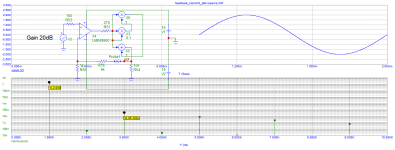
Gain 40dB
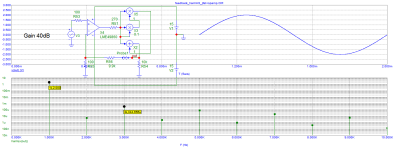
LME 49860 open loop characteristics
Once we convert things into the frequency domain, I think we can disregard 'time' as such because the signal follows a pattern that is unchanging. So, in a simplified way, we could iteratively calculate the errors by going round and round and it takes no time at all.Feedback is not sending the signal “round and round”. It compares actual input value with actual phase shifted divided output value. But you are right in another point, it changes distortion profile and pushes energy into higher harmonics.
In any case, harmonics are a special case of intermodulation, which is actually what's happening. As others have said, it's the real world implementation of NFB that ultimately matters.
What I see is that my posts are immediately highjacked by seasoned engineers that proceed to take it to a high level where it is unreachable for non-EEs.
It appears that my project has failed before it got well underway.
Disappointing.
Jan
You are right. I let my reply to johnhenryharris derail into a long and nonsensical discussion with PMA, my apologies for that.
Last edited:
HI Jan -
FWIW, I do not have an EE background, but I have a reasonable background in science at an American university level. I'm also passionate about learning more about audio at a hobbyist level. I find the posts from you and a few others remarkably informative. Your dedication to sharing your knowledge is greatly appreciated. Since this is a hobby for me, if a topic veers too far out of my comfort zone in detail vs. concept I tend to glaze over. I love to learn, but I fully admit that I'm only willing to 'go so far' in pursuit of understanding / deeper knowledge around certain topics. I'm not doing it for a living, and my time is limited. So, I head directly toward what's fun for me. There are some that would argue that folks like me should really learn their stuff before even assembling a simple kit, but ... I'd disagree.
So, I may be part of your target audience. If I am, wonderful.
To me, the depth of information and detail required to provide a basic understanding of a topic is far less than that required to discuss the successful application and use. The hobbyist that would like to understand a little more about this "hot topic / buzzword" is not necessarily the same as someone that might hope to incorporate negative feedback into a circuit they are designing. I gained important knowledge from both articles. However, I am certain that I didn't get 50% of what I could have learned from the first article. I'd call that a win. If I had even a basic understanding of control theory etc., I may have picked up a few more things that people more versed in the topic focus upon. I think I got 90% or more out of the second article.
For me, your articles struck a nice balance. Did I understand all of it, no! Did they pique my curiosity, yes! Will I continue to try and build fundamental knowledge around some basics, highly likely. Did they point me toward a publication that I never knew existed, yes. If some or all of that was in your goals for writing the articles, then... 😎
Thank you,
Patrick
FWIW, I do not have an EE background, but I have a reasonable background in science at an American university level. I'm also passionate about learning more about audio at a hobbyist level. I find the posts from you and a few others remarkably informative. Your dedication to sharing your knowledge is greatly appreciated. Since this is a hobby for me, if a topic veers too far out of my comfort zone in detail vs. concept I tend to glaze over. I love to learn, but I fully admit that I'm only willing to 'go so far' in pursuit of understanding / deeper knowledge around certain topics. I'm not doing it for a living, and my time is limited. So, I head directly toward what's fun for me. There are some that would argue that folks like me should really learn their stuff before even assembling a simple kit, but ... I'd disagree.
So, I may be part of your target audience. If I am, wonderful.
To me, the depth of information and detail required to provide a basic understanding of a topic is far less than that required to discuss the successful application and use. The hobbyist that would like to understand a little more about this "hot topic / buzzword" is not necessarily the same as someone that might hope to incorporate negative feedback into a circuit they are designing. I gained important knowledge from both articles. However, I am certain that I didn't get 50% of what I could have learned from the first article. I'd call that a win. If I had even a basic understanding of control theory etc., I may have picked up a few more things that people more versed in the topic focus upon. I think I got 90% or more out of the second article.
For me, your articles struck a nice balance. Did I understand all of it, no! Did they pique my curiosity, yes! Will I continue to try and build fundamental knowledge around some basics, highly likely. Did they point me toward a publication that I never knew existed, yes. If some or all of that was in your goals for writing the articles, then... 😎
Thank you,
Patrick
Last edited:
One example ; from very early 50` and on Julius Futterman patented and designed many high performance OTL tube amps which use up to 60dB of GNFB and is unity gain unconditionally stable ,You know what is interesting about history?
That it teaches you some fascinating details.
I was browsing just some old magazines the other day.
In the 50s-60s, every self respected high quality (tube) amplifier had feedback.
For some reason that all of a sudden became out of fashion when it comes down to tube amplifiers.
It seems to be back to feedback again, the last 5 years or so.
lol.
btw , I wonder how much modern solid state amps adjusted to unity gain are uncoditionally stable ?
Attachments
Yes, in much the same way that vanity THD tests on Spice simulators are often done with a 1kHz sine wave.- in case of stationary periodic signal.
More down-to-earth concerns are often avoided or glossed.
For instance, it is rare to see simulated ripples being injected into the power rails. To get started with amplifiers and such, it is far simpler to use a generic laptop supply than play around with transformers and dual supplies, fairly straightforward as they may be. So testing a circuit's immunity to PSU ripple is quite an important measure of how good it is likely to be.
Re: NFB, the whole "voltage amplifier vs current amplifier" thing comes up repeatedly and won't go away until somebody basically re-invents the world's most popular speaker technology so that it's completely free of non-linear inductance. So when we're talking about the amount of negative feedback, by necessity we may be confusing multiple effects, because the usual voltage correction also raises the damping factor / reduces output impedance, which impacts speaker distortion at high frequencies. For a fair test comparing 2 different amplifiers with different feedback levels, the damping factor would also have to be controlled, which may not be possible if it's frequency dependent.
- Home
- Design & Build
- Electronic Design
- Myths, tricks and hey, that's neat!
